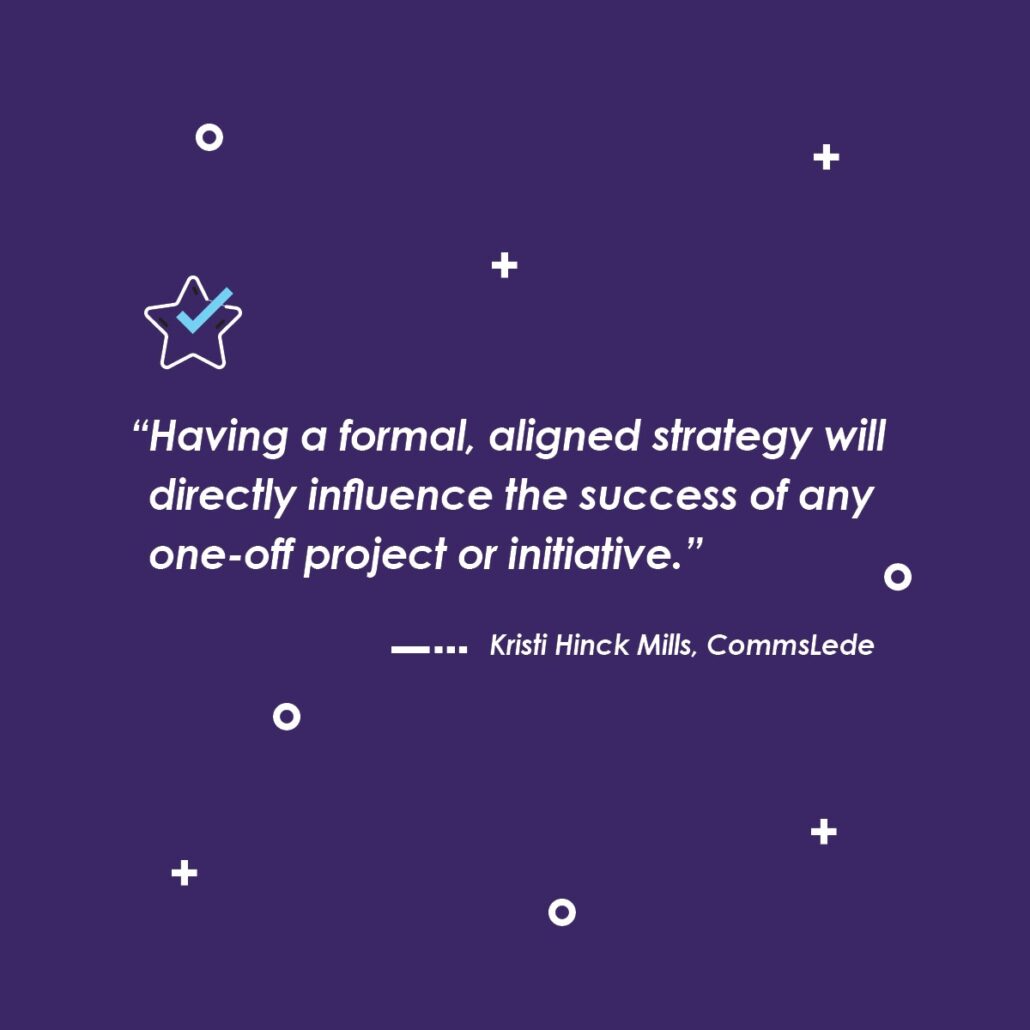
A solid strategy-on-a-page can pay dividends
When starting a project, the first thing I ask a team to share is their organizational or functional “strategy-on-a-page.” The reaction to this question is telling.
- If they can easily access and share their strategy, I know it’s likely being used as a trusted roadmap for the team’s decisions and investments, and we can dive into a project with clear goals and objectives and solid engagement from the start.
- If they look puzzled or ask for more clarification, I can safely assume the team either 1) doesn’t have a formal strategy, or 2) that their strategy is collecting dust, and may be referenced once a year, perhaps around annual review time.
I never judge, since every team is on their own journey.
But I can say with almost one-hundred percent certainty: Having a formal, aligned strategy will directly influence the success of any one-off project or initiative.
Why?
Because if your team or organization can easily connect their day-to-day work to a broader goal, they work more confidently, make decisions more quickly, and can prioritize their tasks and investments more effectively. They also understand the role their work plays in the larger team mission, which can improve collaboration, teamwork, and engagement.
The Hallmarks of a Good Strategy
The term “strategy” can mean many things to many folks, so to level-set, I use my “A-F” checklist to determine a good strategy:
- Aligned – The strategy should directly support leadership goals and directly enable functional activity or tactical work.
- Brief – A strategy should visually fit on a single page, offering a high-level framework for the team’s overarching goals, priorities and supporting activities.
- Clear – When reviewing the strategy, someone outside your organization should directionally understand your goals, and how your team plans to get there.
- Deliverable-tested – Every piece of work or activity your team plans to deliver should align to a strategic goal.
- Embraced – Every team member should understand, internalize and frequently reference the strategy in internal messaging and reporting.
- Fairly evergreen – A solid strategy should last a minimum of 24 months (unless there’s a significant leadership or structure change)
Strategy in Action
A great example of a solid strategy was PepsiCo’s “Performance with Purpose” agenda. Launched in 2006 by then-CEO Indra Nooyi, this significant shift in the company’s approach to business encompassed the brand portfolio, employees, and the company’s sustainability efforts.
While Performance with Purpose was visionary, its success could also be attributed to effective communication internally and externally. The comms team used simple language, clear and consistent definitions and messaging, clean visuals and tools, and storytelling-based proof points.
I’m fairly confident that if you asked any frontline PepsiCo employee in 2010 about Performance with Purpose, they could articulate the goal of growing the business by investing in both people and the planet. Most desk-based employees could also tell you how the company planned to achieve this growth: through brand/product (human), planet (environmental) and people (talent) sustainability.
Why It Worked
The “Performance with Purpose” strategy was brief, clear, and timely. It was also inclusive, incorporating and encompassing every business team. It was directly aligned with PepsiCo’s mission, vision and values, and was effectively cascaded throughout the organization. It was also consistently communicated to both internal and external stakeholders.
Make Your Strategy Your Own
Not every strategy will be as game-changing as “Performance with Purpose” was in its time, but I wholeheartedly believe that if leaders can step back, clearly assess the work and activity their teams intend to deliver, and formally package it in an easily understandable (and simply communicated) framework, you’ll have significant engagement and support from both company leaders and your team.
- Your leaders will know what to expect from your team, the specific work you’re committing to deliver, and how that work directly contributes to the business.
- Your team will be clear regarding the work they’ll be accountable for delivering, and have a guide to prioritize their work accordingly.
- You’ll know where to invest resources … and conversely, where to make cuts if budgets get tight.
- You’ll have a leg to stand on when you need to push back on non-strategic requests.
It’s Not Just a Piece of Paper
Your strategy can be your team’s most important document — but only if it is regularly referenced and used. If you don’t have one today, you’re missing out on an incredibly valuable tool that can foster alignment, strengthen collaboration and engagement, and mitigate team spin. A strategy also gives one-off projects or programs more meaning (and likely creates more engagement), since folks both on and outside your team can connect your work to the bigger picture.
With more than two decades of communications experience spanning agencies, Fortune-100 organizations, non-profits and academia, Kristi Hinck Mills today brings her passion for employee communications to CommsLede Consulting, where she delivers strategic solutions and executive coaching for her clients. Visit the CommsLede blog for more tips.



